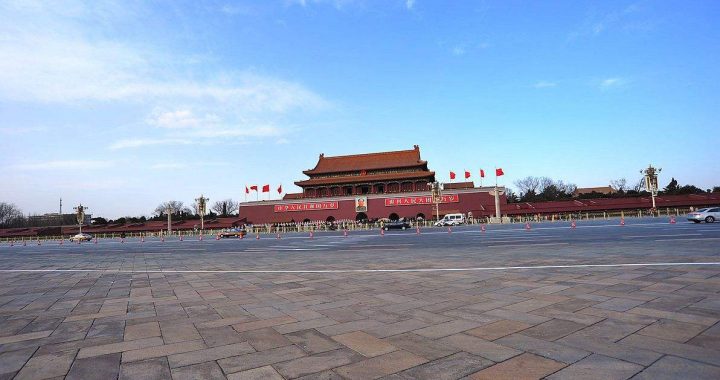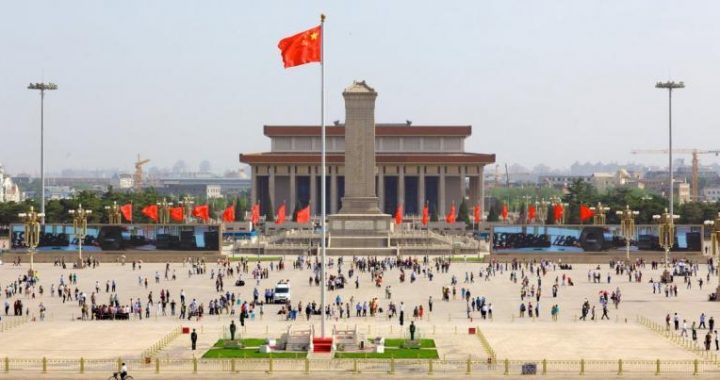Memorial Hall of Chairman Mao
6 min readThe Tian-an Men,which stands above the square,expresses the full talent and intelligence of China’s working people in the art of construction.It could be considered a masterpiece among the ancient structures of Beijing.As for the red walls on the east,west,and south sides of the square,they still obstructed the movement of people and were actually a public nuisance. Therefore, on the tenth anniversary of the founding of the nation, the red walls surrounding the square were totally demolished, and a new square appeared which was several times larger than the old one. On the west and east sides of the square, two modern buildings were constructed. On the west arose the Great Hall of the People, and on the east was built the structure containing the Museum of Chinese History and the Museum of Chinese Revolution. In the center of the square stands the Monument to the People’s Heroes. On the eve of the 30th anniversary of the revolution, the Memorial Hall of Chairman Mao was built on the south side of square, just inside the Zheng-yang Men. The transformation of Tian-an Men Square to the center of political activity was essentially complete. Although its location remains the same, its nature and function have totally changed, and it has an entirely new appearance.
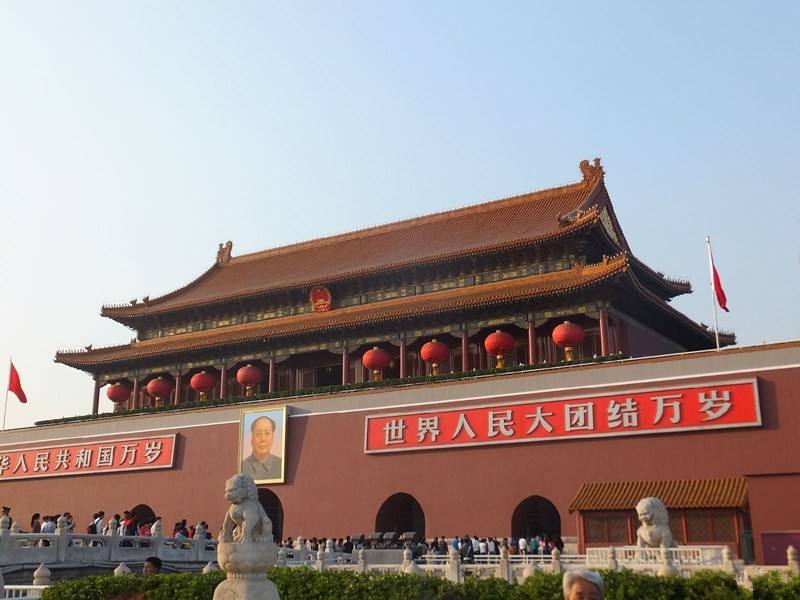
At the beginning of the reconstruction of Tian-an Men Square, its left and right wings extending along Chang-an Street(the street’s name was derived from the former left and right Chang-an Men on either side of the old square) were widened and extended to become a broad, tree-lined thoroughfare. This thoroughfare extended to the east and west suburbs and created a major new axis for the whole city. On one hand this reinforced the primacy of Tian-an Men Square’s location in the layout of the whole city, and on the other hand it relegated the location of the old Forbidden City to “backyard”status. That ancient symbol of imperial primacy thus lost its exalted position relative to the rest of the city.
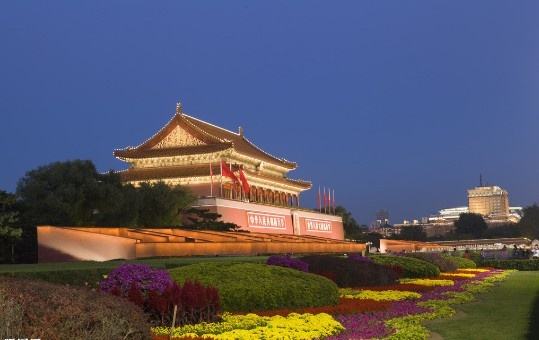
Chang-an Street,Beijing,extending east and west from the Tian-an Men
Although work remains to be done in the reconstruction of Tian-an Men Square,its position as the center of political activity in the city has been established.The old buildings on the square,such as the Tian-an Men and the Zheng-yang Men,and the modern buildings,such as the Great Hall of the People and the Museum of Chinese History and the Museum of Chinese Revolution,all go together very well,showing at the same time continuity with the past and the new spirit of the present.The principle of”weed through the old to bring forth the new”has been fully realized.With regard to the improvement of the layout of Beijing’s Old City,it cannot be said that this was not a success.
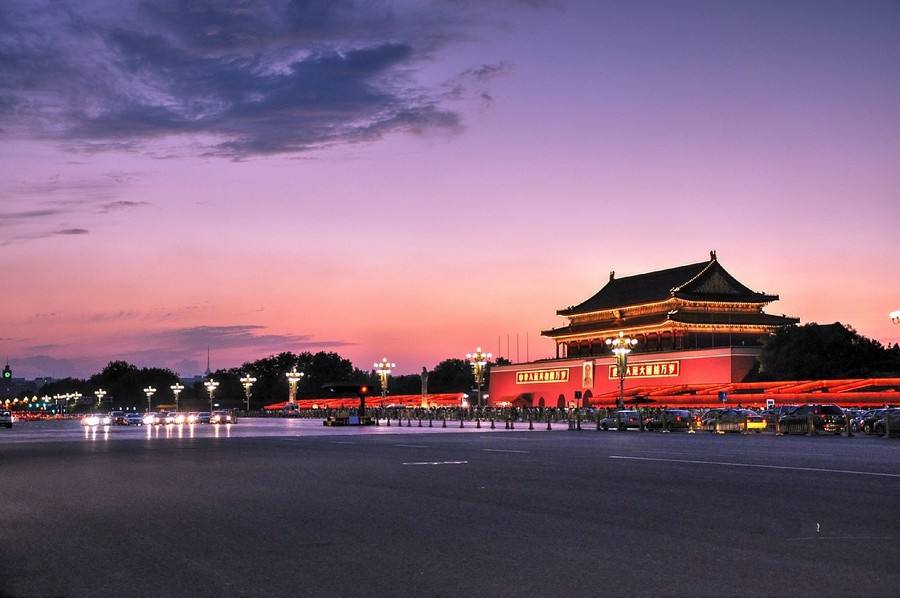
There are still many opportunities for today’s city planners to apply their creative talents, in accordance with this principle, to the reconstruction of Beijing’s Old City.
For instance, one such case is the question of what to do with the old Ji-shui Tan.
Should we consider it an obstacle to the city’s development and fill it in to create land for buildings? Or should we consider it a place of historical significance in the development of the city and protect and improve it?
The Ji-shui Tan of antiquity, as discussed earlier, had a great influence on the location and layout of Beijing’s Old City. The city’s main axis was set next to the eastern shore of Ji-shui Tan, and the width of the lake determined the location of the east and west city walls. It could be said that had Ji-shui Tan not existed, Beijing would not exist in anything like its present form. In Dadu City of the Yuan Dynasty, Ji-shui Tan was of great importance as the northern terminus of the Grand Canal. After theearly period of the Ming Dynasty, when the north city wall was moved southward 2.5 kilometers, the northwest part of Ji-shui Tan was excluded from the city, and the area of the lake inside the city was greatly reduced. Subsequent reconstruction of Beijing’s Old City, while further developing the primary themes of the original city plan, resulted in the filling of the Grand Canal’s bed within the city and the elimination of its upper reaches. All that remained was the spring from Yu-quan Hill, which flowed into Ji-shui Tan and thence on to Tai-ye Chi. After this rearrangement of Beijing’s water system, Tai-ye Chi, which was inside the Royal City, was again enlarged by the addition of a new lake at its southern end. The trees and structures around it increased in number, and it developed into the most scenic park district in the city. The lake became known as the “Three Seas”-the “South Sea”(Nan-hai), the”Middle Sea” (Zhong-hai), and the “North Sea”(Bei-hai). The “North Sea”has now been opened to the public; known as the Bei-hai Park, it is renowned for its most beautiful scenery.
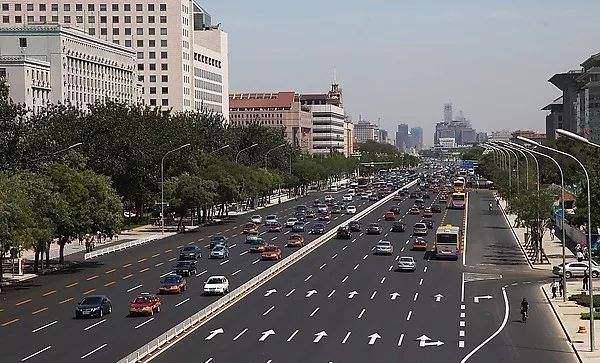
This was the location of the Jin Dynasty’s imperial retreat, Tai-ning Palace.
Ji-shui Tan, which lay outside the Royal City, has a much different fate than the”Three Seas,”with their imperial parks and gardens. Throughout the Ming and Qing dynasties and up to the establishment of New China, it never received much attention from the highest rulers. Thus it has not benefited from any definite plan or development, and has quite naturally become a neglected backwater. The lake shrank into three parts, and only the northwesternmost part was still called Ji-shui Tan. Alarger part of the lake, to the southeast, was called Shi-cha Hai. The area remained, however, one of the most scenic parts of the city. Especially lovely was the view looking west from the east shore of Shi-cha Hai; the reflected peaks of West Mountains seemed like part of the city landscape. Therefore this region in old times, especially during the Qing Dynasty, attracted some of the imperial nobility. They builtgreat houses near the lake shore and channeled lake water into their private gardens.
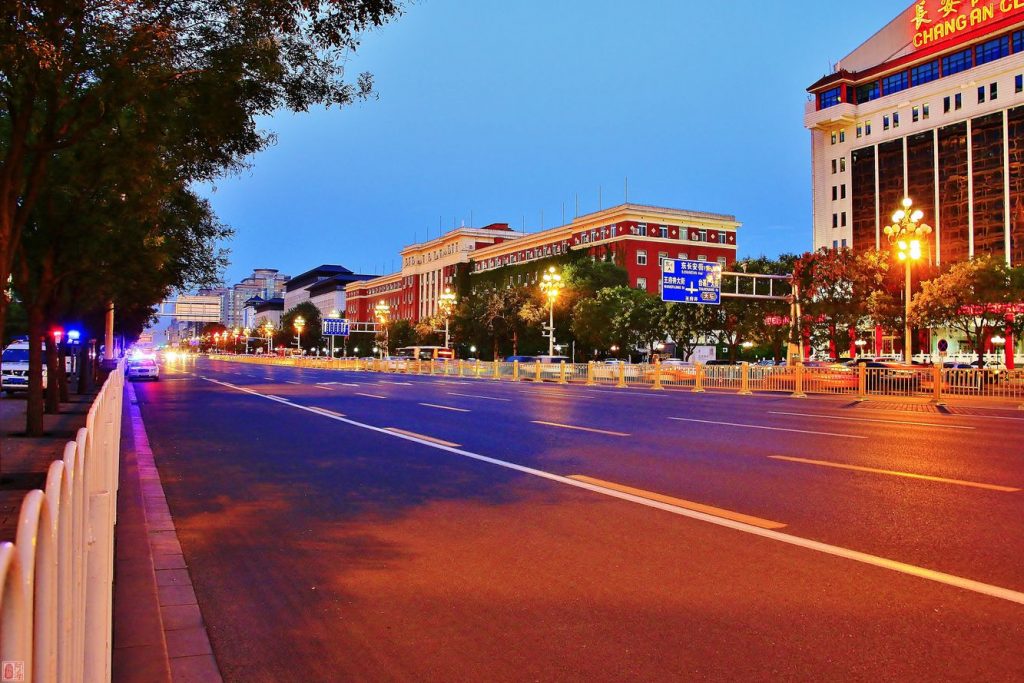
In addition,a number of large, wealthy temples were established around the lake. But,apart from the nobles’ houses and temples, the greatest part of the lake region became a public recreation place for the common people. The southern part, especially, evolved naturally into a real “people’s park.”Concurrently there arose in that place a common people’s market, where prices were low and merchandise was good. Because of a profusion of lotus growing along the lake shore there, this market came to be called the “Lotus Market.”Up to the eve of the birth of New China, this region remained a haven for the common people, where they could relax and enjoy life in a rustic setting. This informality contrasted sharply with the detailed planning and arrangement of Tai-ye Chi and its imperial gardens.
Now, inside Beijing’s Old City, this overlooked lake is still there, and along its shores there are still patches of greenery and glimpses of its former beauty.
Further planning and reconstruction of the Ji-shui Tan district has already beenscheduled as part of the effort to improve and reconstruct Beijing’s Old City, in coordination with the overall plan for greater Beijing. As this process goes forward, we must consider the historical importance and value of this region. We must consider the strong association of the common people with this place and the present necessity of creating more spacious, pleasant and culturally meaningful recreation areas for our citizens. We must consider the potential for improving the natural environment and making the city a more beautiful place. We must also build our plan upon the historical base we have inherited, all the while maintaining a critical attitude and doing our best to realize the principle of “weeding through the old to bring forth the new.”Ji-shui Tan is waiting for us to make this effort.
